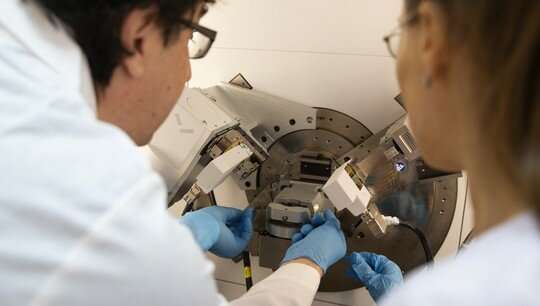Senior research fellows at the Laboratory of Precision Alloys and Intermetallic Compounds of the Institute of Metal Physics of the Ural Branch of the Russian Academy of Sciences are preparing the second-generation high-temperature superconducting tape samples for the diffractometer survey. Credit:Evgeniy Talantsev
An international research team headed by Evgeniy Talantsev, a senior research fellow at the Research and Educational Center of Ural Federal University, has approached the task of increasing the reliability of such complex and expensive facilities as the Large Hadron Collider (LHC). The results of the experiment were published in the journal Scientific Reports in an article titled "The onset of dissipation in high-temperature superconductors: magnetic hysteresis and field dependence."
Evgeniy Talantsev explains, "In the process of working with second-generation high-temperature superconductors at liquid nitrogen temperatures (appr. -190 degrees Celsius), we found that with increasing electric current, the onset of electrical power dissipation is clearly associated with an abrupt transition from the nonlinear behavior of the magnetic field created by the electric current (and measured at any point on the superconductor's surface), to the linear. A linear increase in the magnetic field and a linear increase in current is a common dependence inherent to metals and semiconductors, i.e. materials with a regular linear electrical resistance, to which Ohm's law is applicable.
"In other words, even though the electrical resistance of superconductors at the onset of dissipation is about hundreds of billions of times lower than that of the best metal, and is very non-linear and increases tens of millions of times, the behavior of the magnetic field depending on the amperage turned out to be linear and easily detected by regular cryogenic Hall sensors," Talantsev says.
The experiment was first conducted without any external applied magnetic field, and therefore, without a multitude of extra effects that occur in superconductors when the external magnetic field is applied.
"The experiment without an externally applied magnetic field is very pristine and simple. But no one conducted it and analyzed the results before us: Everyone ran it in a strong magnetic field. The significance of our approach is that we closed all the loopholes in explaining the results as the influence of the external magnetic field. Thus, it is fair to say that the effect that we found is of a fundamental nature," the researcher explains.
The scientists also checked if the effect of the transition from nonlinear to linear magnetic field dependence was still present with the increase in current when applying a strong magnetic field to the superconductor. This is important, because the conditions of the technological disaster in the Large Hadron Collider included the external magnetic field being applied.
"It turned out that in experiments with external applied magnetic field, the linear characteristics of the superconductor's own magnetic field, observed at the onset of power dissipation are identical to those observed without the external magnetic field. Thus, we have shown that the onset of power dissipation regimes, contrary to the traditional assumptions, are the same with or without the external applied magnetic field," Evgeniy Talantsev says. "In addition, in this paper, we showed that the superconductor remembers its magnetic history forever. All changes that occur even without power dissipation are remembered by the superconductor for an indefinitely long time. This memory effect is called hysteresis."
The physical principles of the effect discovered during the experimental observation are to be substantiated theoretically. Here, Evgeniy Talantsev is counting on the assistance of scientists and students of the the Research and Educational Center for Nanomaterials and Nanotechnologies. Meanwhile, Evgeniy Talantsev's team is planning to continue experiments at low temperatures using liquid helium, under conditions almost identical to the conditions of the Large Hadron Collider.
The Large Hadron Collider is a 27-kilometer underground facility on the border between Switzerland and France for colliding elementary particles accelerated to near-light speed. By registering the collisions of particles, scientists try to look into the mystery of the creation and the structure of the Universe. These studies are only possible in conditions where the flow of elementary particles is compressed by a strong magnetic field, a million times stronger than the magnetic field of the Earth. Such fields are created using superconductors, in which a giant no-loss electric current circulates in an inductor almost 27 kilometers in length, which is the basis of the LHC. An increase in the energy of colliding particles is possible only if the magnitude of the magnetic field is increased. The productivity of superconductors, in turn, is ensured by cooling with liquid helium: this substance does not harden even at an absolute zero temperature: -273.15 degrees Celsius.
In September 2008, due to the uncontrollable behavior of the 27 km superconducting inductance coil at the Large Hadron Collider, the largest technological superconducting disaster, the so-called "Quench," occurred—this was the destruction of the superconducting state of the superconductor. The planned increase in the current in the coil resulted in damage to the LHC's cryogenic system. About six tons of liquid helium evaporated into the atmosphere (note that 1 liter of liquid helium is about 125 grams, and costs about €100 euros). Fortunately, there were no casualties, but the LHC, which suffered significant damage due to uncontrolled energy dissipation, was out of operation for more than a year. European science suffered multi-million-dollar losses.
The research paper was published in the Scientific Reports.
More information: E. F. Talantsev et al. The onset of dissipation in high-temperature superconductors: magnetic hysteresis and field dependence, Scientific Reports (2018). DOI: 10.1038/s41598-018-32811-6
Journal information: Scientific Reports
Provided by Ural Federal University
























